SOURCES OF ENERGY for Class 10 PHYSICS
INTRODUCTION
Kisi bhi type ke work ke liye energy chahiye hoti hai. Energy ke karan hum different type ka kaam kr pate hain. Koi chiz jo hume energy provide krta hai usse source of energy kehte hain. Human beings ko work krne ke liye energy ki jarurat hoti hai aur unke energy ka source food hai. Hamara body food ko burn krta hai aur energy produce krta hai. Aisa jaruri nahi hai ki sirf living organisms hi work krte hain, non-living objects bhi work krte hain, jaise ki hamare ghar me laga electric bulb. Bulb ka kaam hota hai glow krna. Bulb glow tabhi kr pata hai jab usse electric current milti hai. Electric current electrical energy ka form hota hai jiska source power plants hai.
ENERGY
Work karne ki capacity wo energy kehlata hai. Energy is the Capability or ability to do work. Aapke din bhar ke routine me energy ki jarurat hoti hai, personal kaam ho, padhai ho, games khelna ho, ya projects banana ho, in sabhi kaam me energy jaruri hai. Jo bhi hum khate pite hain usse hamara body burn krta hai aur ATP ke form me energy produce hota hai. Is energy ko hum utilize krte hai aur different kaam krte hain.

SOURCE OF ENERGY
Koi chiz jo hume energy provide krta hai usse source of energy kehte hain. Source of energy kya hai? Ek aisi jagah jahan se continuously useful energy aa rahi hai, steady rate pr lambe samay se. Kuchh examples sources of energy ke hain; power plants jahan se electrical energy aata hai, coal jisse burn krne pr heat aur light energy produce hota hai, petrol, diesel, kerosene jinhe burn krne pr chemical energy release hota hai.A source of energy is one which can provide an adequate amount of energy in a convenient form over a long period of time.
WHAT IS A GOOD SOURCE OF ENERGY?
Energy different types ke hote hain aur energy source se aati hai toh sources ke bhi different types ke hote hain. In sabhi different types me se hum best source of energy choose krte hain. Jo bhi hum source of energy choose krte hain usse large amount of work krna chahiye per unit volume or mass, safe aur convenient hona chahiye. Ager hume khana banana hai, toh hume aag chahiye. Aag hamare pass do tarike se aa sakti hai, wood aur LPG cylinder ke through. Wood ur LPG cylinder dono hi energy ke source hain, inme se good ya better source of energy kaun sa hai? LPG cylinder wood se better energy ka source hai kyunki ye jyada convenient hai use krne ke liye.Qualities of a good source of energy:
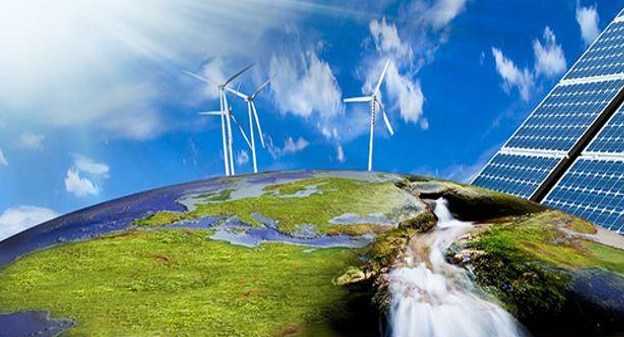

RENEWABLE OR NON-CONVENTIONAL SOURCES OF ENERGY
Earth pr human beings ke liye Sun main source of energy hai. Natural sources (wind, flowing water, tides, ocean waves, biogas) se jo energy utpan hote hai vo directly ya indirectly Sun ke energy se derive hote hain. Hydro Energy, geo-thermal energy aur nuclear energy dusre sources of energy hain jo hume jyada time period ke liye energy provide krte hain. In energy ke sources ko hum baar baar use kr sakte hain aur ye kabhi exhaust nahi honge. Non-conventional sources of energy utne jyada use nahi ho pa rahe hain aur jo bhi hamari requirements hain unko ek particular limit tak hi fulfil kar sakte hain (used only on a limited scale).Examples:
A natural source providing us energy continuously is called a renewable (or non-conventional) source of energy.
NON-RENEWABLE OR CONVENTIONAL SOURCES OF ENERGY
Conventional sources of energy ko hum bahut phehle se use krte aa rahe hain aur bahut jyada use kr rahe hain. Jo bhi hamare major energy ke requirements hain hum wo conventional sources ke karan fulfil kr pa rahe hain.Examples:
The sources of energy which have accumulated in nature over a long period and cannot be quickly replaced when exhausted, are called non-renewable or conventional sources of energy
FOSSIL FUELS
Coal, petroleum and natural gas (these are known as fossil fuels). Fossil fuels plant aur animal remains ke decomposition se form hote hain jo millions of years pehle earth me bury hue the. Fossil fuels ke formation me millions of years lagta hai. Ager hum inka bahut jyada use krenge to inka reserves deplete ho jaega aur exhaust hone ke baad inhe jaldi regenerate nahi kr paenge.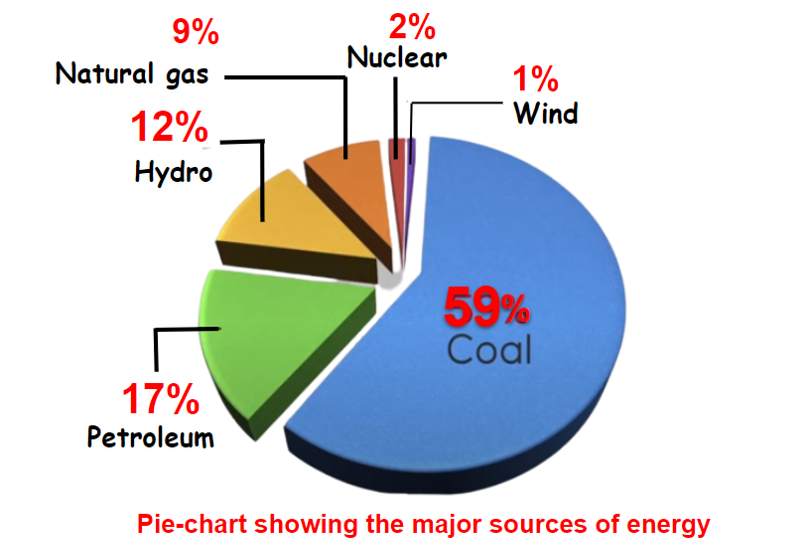
Coal: Coal ek sedimentary rock hai jo burn hota hai. Ye non-renewable source of energy hai jo mainly carbon, hydrogen aur oxygen jaise complex compounds se bana hai aur usme kuchh quantity sulphur aur nitrogen ka hota hai. Coal earth ke surface ke niche deep mines me milta hai. India me coal mines Jharkhand, West Bengal, Odisha and Chhattisgarh me hain. India me coal common source of energy hai.
Different types of coal are:
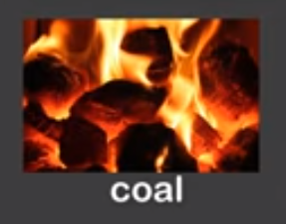

Kisi substance ko jab air ke absence me heat krte hain toh us process ko Destructive distillation kehte hain. Coke, coal tar, coal gas, aur ammoniacal liquor destructive distillation process se obtain hote hain.
Petroleum: Petroleum is a dark coloured viscous liquid also called crude oil.Ye non-renewable source of energy hai jo earth ke crust me rocks ke beech trapped hota hai. Ye bahut sare hydrocarbons (with water, salt, earth particles and other particles of carbon, nitrogen and sulphur) ka complex mixture hai. Ye pani se lighter hota hai aur pani me mix nahi hota hai. Petroleum ko earth crust me oil wells ko drill krke obtain kr sakte hain. India me petroleum ke reservoirs Assam aur Mumbai me hain.Crude petroleum jo wells se extract hota hai use natural form me as fuel use nahi kr sakte. Use purify ya refine krna hota hai different useful components ko obtain krne ke liye.The process of separating useful components from crude petroleum is called refining.

Natural gas: Natural gas non-renewable energy source hai jo earth ke crust me deep found hota hai. Ye alkanes ka mixture hota hai (i.e. 80% methane, 7% ethane, 6% propane aur 4% butane).
Pollution caused by fossil fuels:
Controlling pollution caused by fossil fuels:
THERMAL POWER PLANT
Thermal power plants coal aur petroleum ke combustion se jo heat produce hota hai usse electricity generate krte hain. Power stations me roj fossil fuels large amount me burn hote hain water ko heat krne ke liye aur steam produce krne ke liye. Steam turbine ko run krta hai aur electricity produce krta hai. Power stations ko coal aur oil fields ke ps set up krte hai transportation aur production ke cost ko minimize krne ke liye. Electricity ka transmission bahut efficient hota hai.Thermal power plant ek power plant hai jo heat energy ka use krke electricity produce krta hai.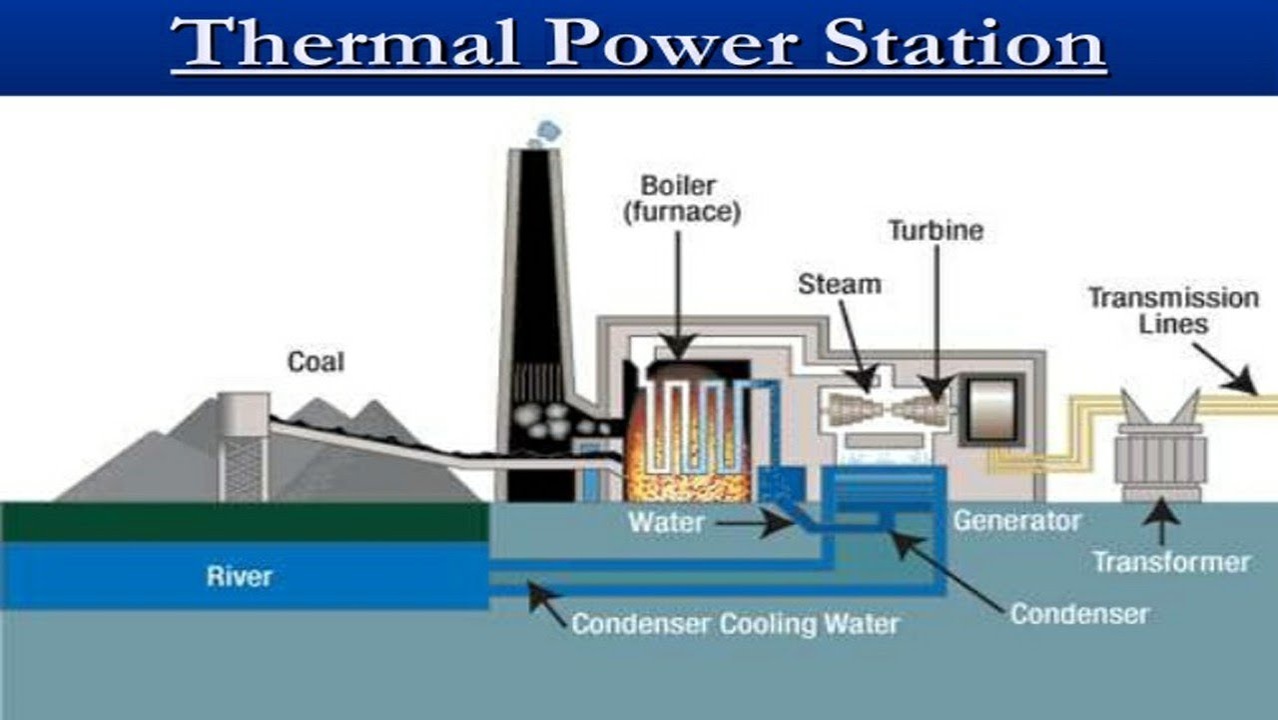
HYDRO POWER PLANTS
Jin power plants me pani ka use kiya jata hai, current produce krne ke liye unhe Hydro Power Plants kehte hain. Hydro power plants falling water ke potential energy ko electricity me convert krta hai. Jab rivers ke flowing water ko dam me store krke dam ke top se fall krate hain, to water bahut force se niche aata hai. Ye force large turbines ko drive krne me use krte hain. Ye turbines electric generators se connected hote hain aur electric current generate krte hain. Is process me jo electricity generate hota hai use hydroelectricity ya hydel power kehte hain. Is process me water ka potential energy kinetic energy me change hota hai aur phir electric energy me. Ye sabse conventional renewable energy source hai jo obtain hota hai jab pani ko bahut height se fall krate hai.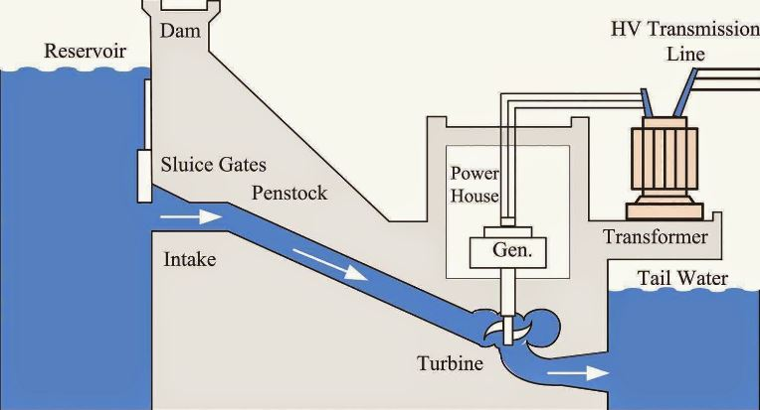
ADVANTAGES OF HYDRO POWER PLANTS
1. Environmental pollution nahi hota hai.
2. Flowing water renewable source of electric energy hai.
3. Dams ka construction flood prevent krta hai aur irrigation ke liye pani provide krta hai.
DISADVANTAGES OF HYDRO POWER PLANTS
1. Dams banane me agricultural lands, flora, fauna aur human settlements sab destroy ho jate hain.2. Ecosystems destroy hota hai.
3. Underwater vegetation ke karan, large amounts of methane produce hota hai jo ek greenhouse gas hai.
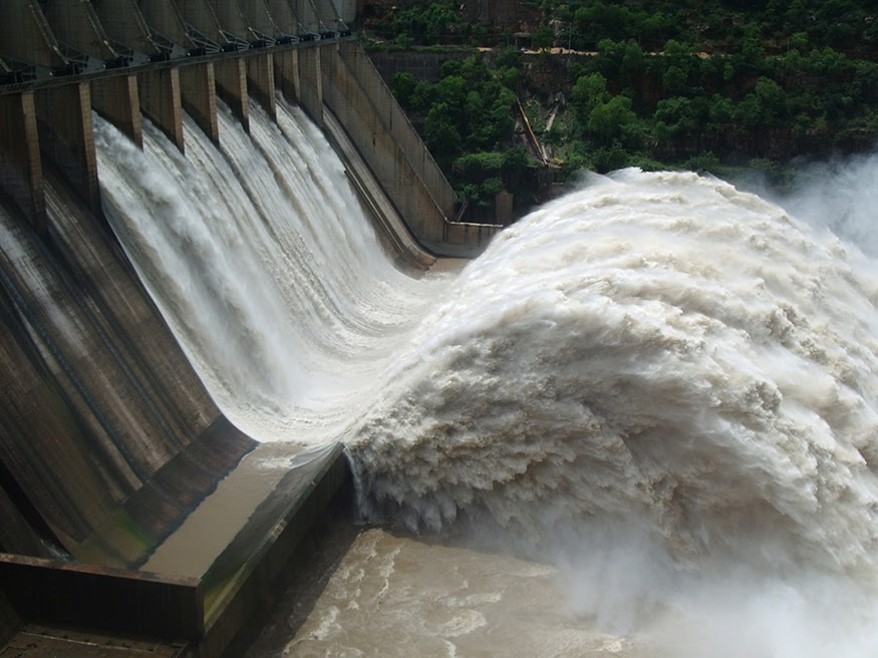
DISTINCTION BETWEEN RENEWABLE SOURCES AND NON-RENEWABLE SOURCES OF ENERGY
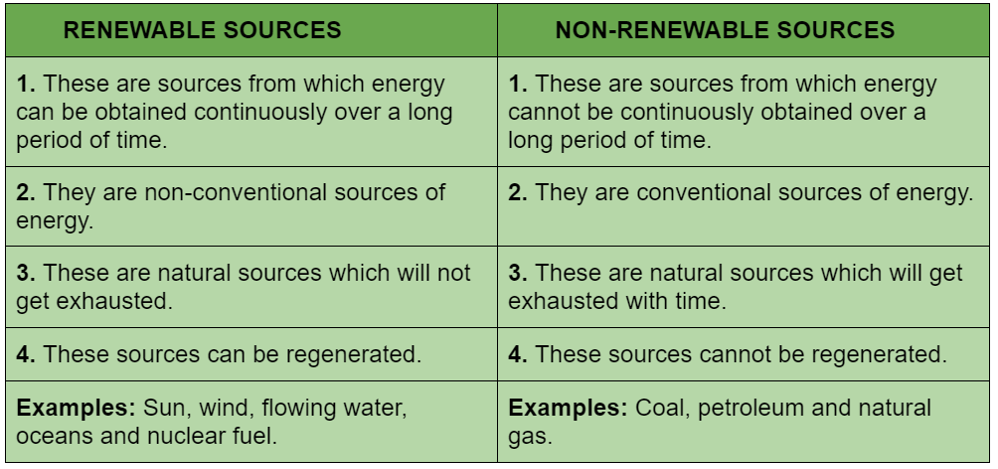
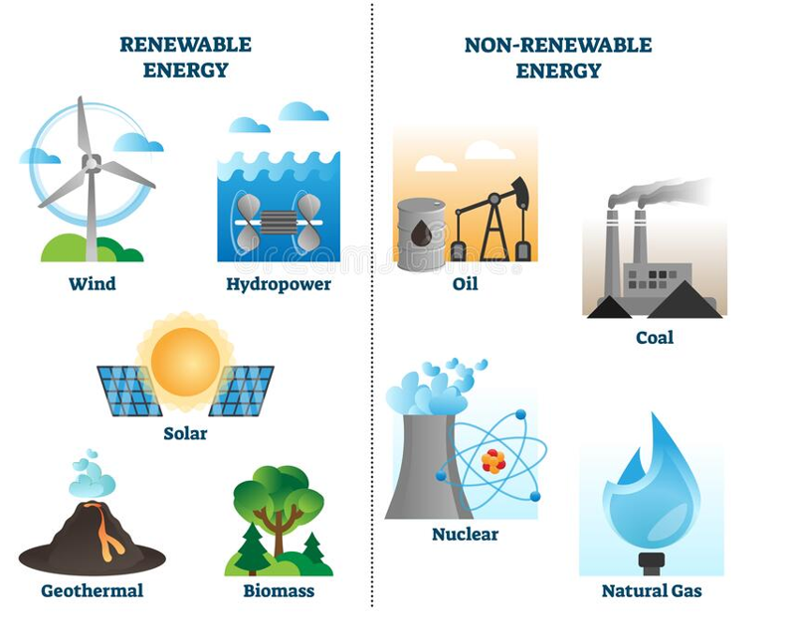
IMPROVEMENTS IN THE TECHNOLOGY FOR USING CONVENTIONAL SOURCES OF ENERGY
BIOMASS
Living beings (plants, trees aur animals) ke waste aur dead parts ko use krte hain, energy derive krne ke liye. Biomass carbon compounds contain krta hai. Biomass me jo chemical energy stored hota hai use bioenergy kehte hain. Bioenergy solar energy se milta hai. Wood, cattle dung, crop residue aur agricultural waste jaise biomass ko traditionally domestic aur commercial purpose ke liye as fuel use krte hain heat energy produce krne ke liye. Biomass ka best example biogas hai. Biomass biogas produce krne ke liye bhi use krte hain jab oxygen ke absence me uska decomposition krte hai. Biogas ka main constituent methane (65%) hai aur baki carbon dioxide, hydrogen aur hydrogen sulphide ka mixture hota hai. Biogas ko engines run krne ke liye aur electricity produce krne ke liye as fuel use krte hain.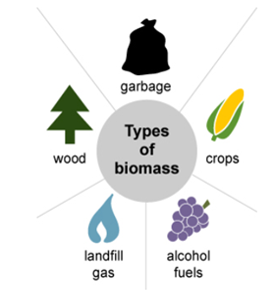
India me do type ke biogas plants hote hain:
1. Floating gas folder type
2. Fixed dome type.
Inhe Gobar gas plants bhi kehte hain kyunki main biomass jo in me use hota hai vo slurry (mixture of animal dung or gobar in water) hai.

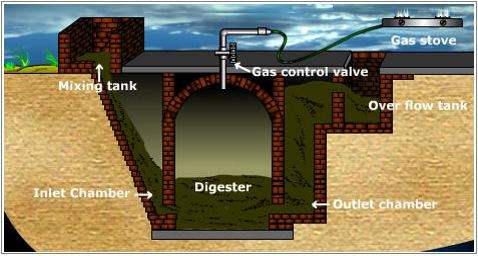
Advantages of Biogas:
1. Biogas excellent fuel hai.
2. Biogas ka heating capacity high hota hai.
3. Smoke ke bina burn hota hai aur koi residue nahi leave krta hai.
4. Lighting ke liye use hota hai.
5. Waste disposal ka safe aur efficient method hai.
WIND ENERGY
Solar radiations se landmass aur water bodies me jo unequal heating hota hai usse air movement generate hota hai aur wind blow krta hai. Moving air ka large mass ko wind kehte hain. Motion ke kran usme kinetic energy hota hai. Wind ke kinetic energy ko wind energy kehte hai. Wind energy solar energy se milta hai.Uses of kinetic energy generated by wind energy:
1. Turbine ke rotor ko turn krke electricity generate krta hai.
2. Well se pani nikalne ke liye.
3. Flour mills run krne ke liye.
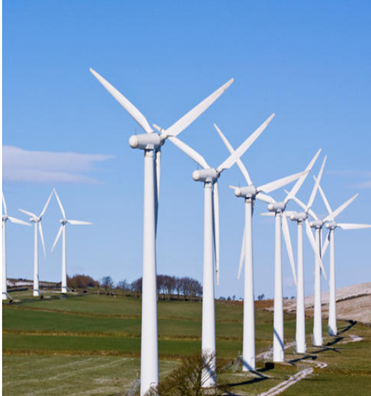
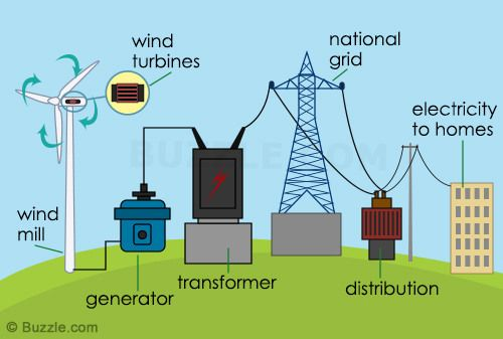
Advantages of wind energy:
1. Eco-friendly
2. Efficient source of renewable energy.
3. Electricity production me baar baar expense nahi lagta hai.
Disadvantages of wind energy:
1. Wind energy farms ke liye large area of land lagta hai.
2. Wind energy farms ko establish krne ka cost bahut jyada hota hai.
3. Windmills ke blades ko high level maintenance lagta hai.
4. Wind speed hamesha uniform nahi hota hai.
ALTERNATIVE OR NON-CONVENTIONAL SOURCES OF ENERGY
Solar Energy
Sun ultimate source of energy hai earth pr. Heat aur light energy ke form me jo energy sun se produce hota hai usse solar energy kehte hain.Solar energy devices:
1. Solar cooker
2. Solar water heater
3. Solar cells.
Black surfaces white or reflecting surface ke comparison me jyada heat absorb krte hain.Solar cookers aur solar water heaters isi property pr work krte hain. Kuchh solar cookers me mirrors (to focus the rays of the Sun) hote hain jisse vo higher temperature achieve kr pate hain. Solar cookers glass plate se covered hote hain.
Advantages of Solar Cookers
Disadvantages of Solar Cookers

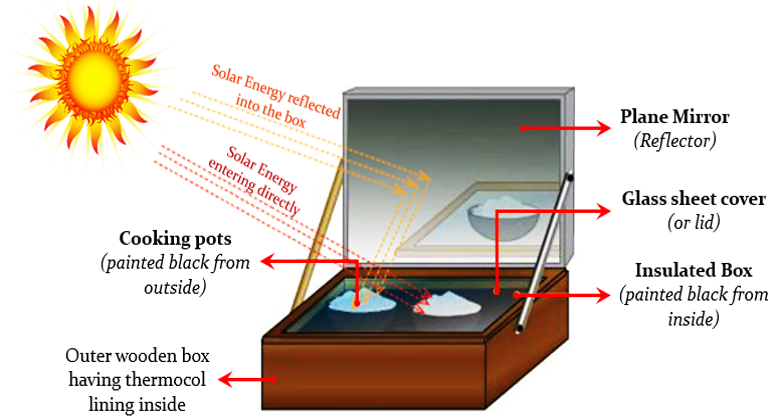
Solar energy most commonly used renewable energy source hai. Kya aap jante hain ki solar energy ko kaise electricity generate krne me use krte hain? Solar ya light energy ko electric energy me convert krne me Photovoltaic or PV system ka use krte hain. PV system ka basic component Solar cell hota hai. Ek single solar cell 0.5 V electricity produce kr sakta hai. Solar panel bahut sare solar cells ka combination hota hai. Solar cells ke number ko increase krke solar panel voltage ko increase kr sakte hai.
Example: 30 solar cells jo series me connected hote hain vo 15 V electricity produce krte hain.
A large number of solar cells are combined in an arrangement called solar cell panel that can deliver enough electricity for practical use.
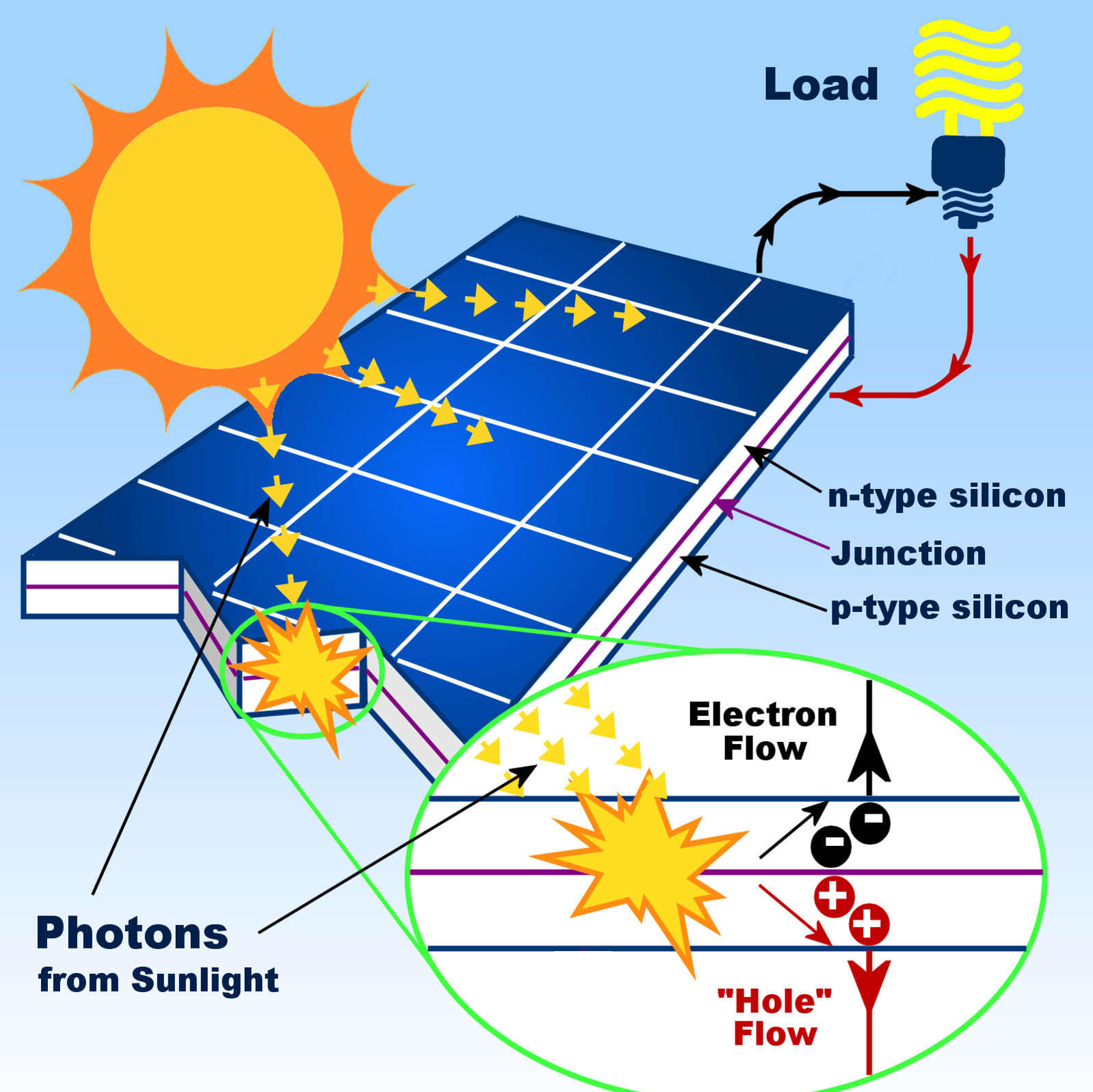
Advantages of Solar Cells
1. No moving parts.2. Require little maintenance and work quite satisfactorily without the use of any focussing device.
3. They can be set up in remote and inaccessible hamlets or very sparsely inhabited areas in which laying of a power transmission line may be expensive and not commercially viable.
Disadvantages of Solar Cells
1. The entire process of manufacture is still very expensive, silver used for interconnection of the cells in the panel further adds to the cost..
2. The domestic use of solar cells is, however, limited due to its high cost.

ENERGY FROM THE SEA
TIDAL ENERGY
The rise of ocean water near the coast is called high tide and fall of ocean water is called low tide. Tidal waves ka ocean me rise aur fall din me do baar occur hota hai. The energy possessed by rising and falling of water in tides is known as tidal energy. Tidal energy ko electricity generate krne me use krte hain dams construct krke.WAVE ENERGY
Due to the wind blowing on the surface of oceans, waves move at high speed on its surface which are called oceanic waves (or sea waves).Unke high speed ke karan, ve tremendous amount of kinetic energy carry krte hain.The kinetic energy possessed by fast moving oceanic waves is called oceanic waves energy.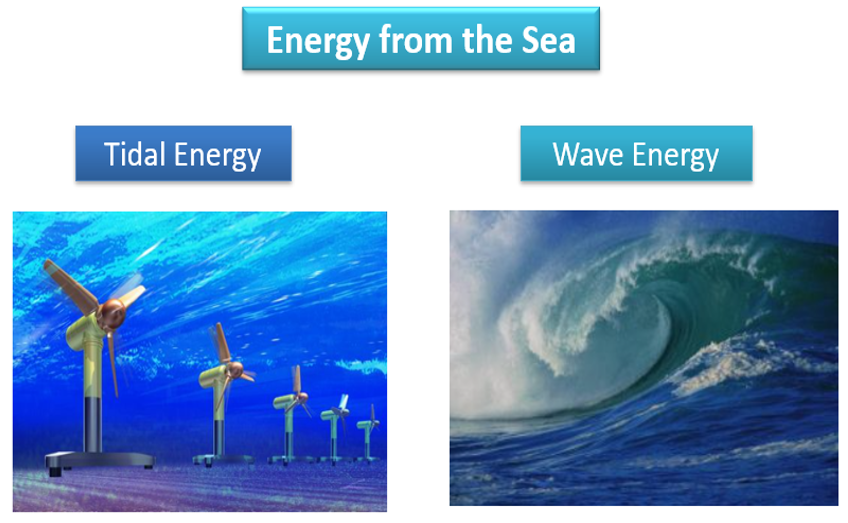
OCEAN THERMAL ENERGY
Ocean ke surface pr pani heat ho jata hai sun ke heat ko absorb krke jabki ocean ke deeper levels pr pani thanda hota hai. Isi karan different level pr pani ka temperature different hota hai.The energy available due to the difference in temperature of water at the surface and at deeper levels of oceans is called ocean thermal energy (OTE).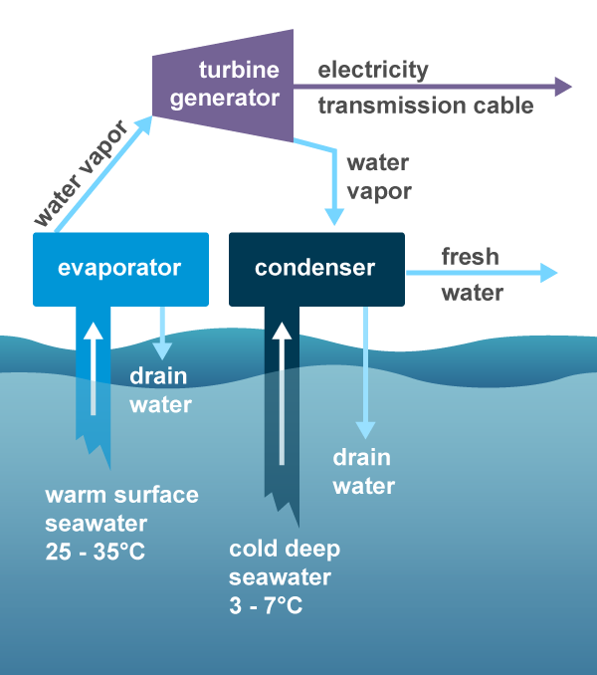
Ocean thermal energy conversion renewable energy conversion technology hai jo surface sea water aur deep sea water ke temperature difference ka use krke power generate krta hai.
GEOTHERMAL ENERGY
Geo ka mtlb earth hai aur thermal ka mtlb heat hai. Geothermal energy is the heat energy from hot rocks present inside the earth. Molten rocks jo earth ke crust ke deep hot regions me geological changes ke karan form hote hain vo upward push ho jate hain aur certain regions jinhe hot spots kehte hain unme trapped ho jate hain. Underground water jab hot spot ke contact me aata hai to steam generate hota hai. Rocks me trapped steam ko pipes ke through turbine se route krte hai electricity generate krne ke liye. Geothermal energy pr based bahut sare power plants New Zealand aur United States of America me operate hote hain.Advantages of Geothermal Energy
Disadvantages of Geothermal Energy
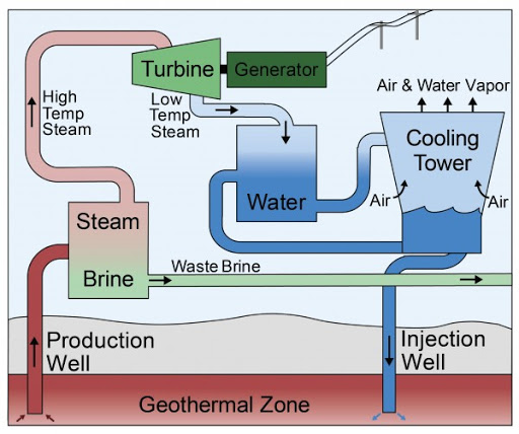
NUCLEAR ENERGY
The energy released during a nuclear reaction is called nuclear energy. Radioactive atom (such as uranium, plutonium or thorium) ko jab low energy neutrons se bombard krte hain to us radioactive atom ka heavy nucleus smaller nuclei me split hota hai. Is process koWorking of nuclear fission
Nuclear reactor me self-sustaining chain reaction controlled rate me energy release krte hain jo steam produce krne ke liye aur electricity generate krne ke liye use hota hai.Major Nuclear Power Plants:
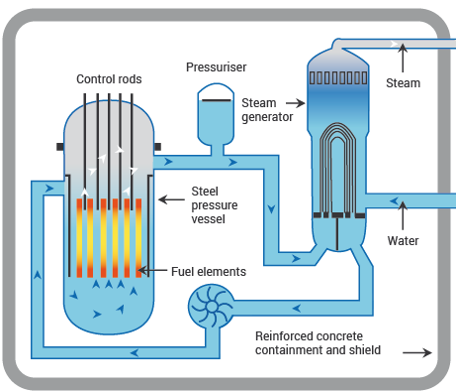
DISTINCTION BETWEEN NUCLEAR FISSION AND NUCLEAR FUSION
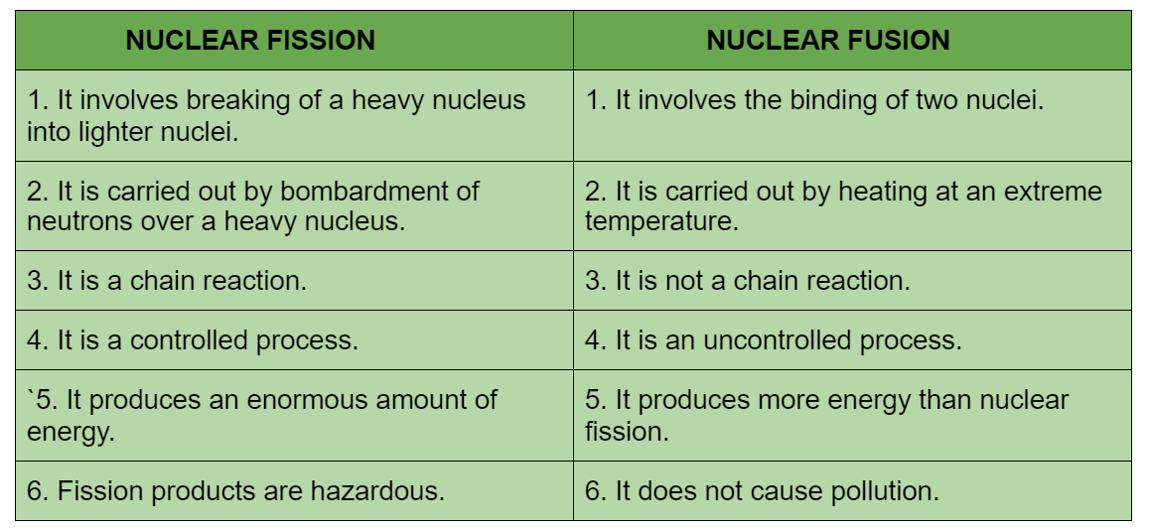
Advantage of Nuclear Fusion:
1. Bahut small amount of nuclear fuel se large amount of useful energy produce hota hai.
2. CO2 jaise greenhouse gases produce nahi hota hai.
Limitations of Nuclear Fusion:
1. Environmental contamination due to improper nuclear waste storage and its disposal.
2. There is a risk of accidental leakage of nuclear radiation.
3. There is a high cost of installation of a nuclear power plant.
4. Limited availability of nuclear fuel (uranium).
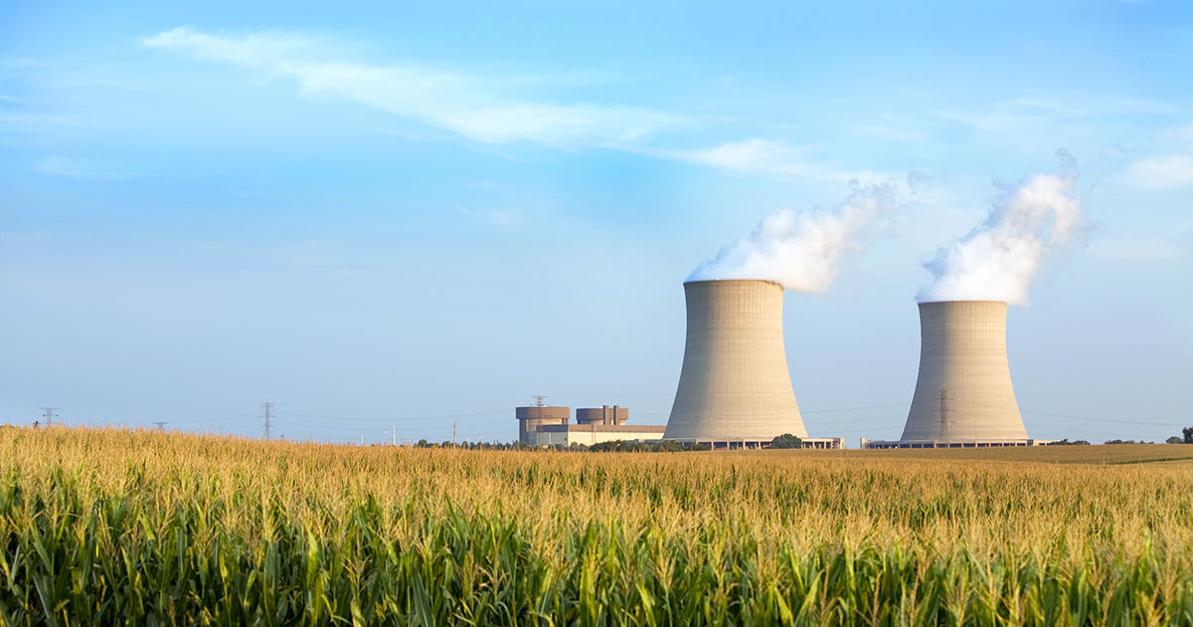
ENVIRONMENTAL CONSEQUENCES
Kisi source of energy ko exploit karne se environment disturb hota hai. Energy source jo hum choose krte hain, vo following factors pr depend krta hai:1. Source se energy ko extract krna kitna easy hai.
2. Source se energy ko extract krne me kitna cost lagta hai.
3. Us source ko use krke jo environmental damage cause hota hai.
Koi source of energy pollution free nahi hota hai, ek source dushre source se clean hota hai. Example: Solar cells pollution free hote hain lekin device ke assembling me kuchh environmental damage cause hote hain.
POINT 1
A source of energy is one which can provide an adequate amount of energy in a convenient form over a long period of time.
A natural source providing us energy continuously is called a renewable (or non-conventional) source of energy.
The sources of energy which have accumulated in nature over a long period and cannot be quickly replaced when exhausted, are called non-renewable or conventional sources of energy.
The process of separating useful components from crude petroleum is called refining. Petroleum is a dark coloured viscous liquid also called crude oil.
The kinetic energy possessed by the flowing water is called hydro energy.
The kinetic energy of wind is called wind energy.
The chemical energy stored in the biomass is called bioenergy.
The energy possessed by rising and falling of water in tides is known as tidal energy.
The kinetic energy possessed by fast moving oceanic waves is called oceanic waves energy.
The energy available due to the difference in temperature of water at the surface and at deeper levels of oceans is called ocean thermal energy (OTE).
Geothermal energy is the heat energy from hot rocks present inside the earth.
EXAMPLE 1
Why is there a need to harness non-conventional sources of energy ? Give two main reasons.
There is a need to harness non-conventional sources of energy due of the following reasons
(i) The energy demands are increasing repidly because of population explosion and our efforts to improve the quality of the life by adopting faster means of transportation, rapid industrialisation and extensive use of energy-fed appliances.
(ii) The sources of energy which are available are mainly fossil fuels which are non-renewable sources of energy and are limited. It will get exhausted after a time being. So, we need to harness non-conventional sources of energy.
EXAMPLE 2
Make list of conventional and non-conventional sources of energy. Give a brief discription of harnessing one non-conventional source of energy.
The following are the list of conventional and non-conventional sources of energy
(i) Conventional sources of energy They are those which are used extensively and meet a major portion of our energy requirement. These are fossil fuels (wood, coal and petrol), hydro energy, biomass energy and wind energy.
(ii) Non-conventional sources of energy They are those which are not used as extensively as conventional ones and meet our energy requirement only on a limited scale. These are socal energy, ocean energy (tidal energy, wave energy and ocean thermal energy), geothermal energy and nuclear energy.
The harnessing of one non-conventional source of energy is as follows
Nuclear energy Nuclear energy is produced by the release of heat from unstable elements such as uranium. The energy is harnessed by using the energy to heat water.
The radioactive water is then pumped through a heat exchanger where the dirty water is used to heat clean water. The clean water can then be used to derive turbines and other forms of engine.
EXAMPLE 3
What steps would you suggest to minimise environmental pollution caused by burning of fossile fuels ?
The following steps can be would suggested to minimise environmental pollution caused by burning of fossil fuels
(i) Using smokless appliances and using various techniques to reduce the escape of harmful gases.
(ii) Converting land into forest by planting trees.
(iii) Using clean fuels like CNG, LPG, etc.
(iv) By using public transport instead of private vehicles.
(v) By increasing the efficiency of combustion process.
EXAMPLE 4
Write two different ways of harnessing energy from ocean.
The two different ways of harnessing energy from ocean are as follows
(i) Tidal energy The energy derived from rising and falling ocean tides is called tidal energy. The tidal energy can be harnessed by constructing a tidal barrage or tidal dam across a narrow opening to the sea.
(ii) Ocean thermal energy Solar energy stored in the oceans in the form of heat is known as ocean thermal energy. Temperature differences between the deep ocean water and upper level is used to produce ocean thermal energy. The process of harnessing the thermal energy of the sea is called ocean thermal energy conversion.
POINT 2
Source of energy :
A source of energy is one which can provide an adequate amount of energy in a convenient form over a long period of time.
Renewable or Non Conventional Sources of Energy :
A natural source providing us energy continuously is called a renewable (or non-conventional) source of energy.
Non Renewable or Conventional Sources of Energy :
The sources of energy which have accumulated in nature over a long period and cannot be quickly replaced when exhausted, are called non-renewable or conventional sources of energy.
Refining :
The process of separating useful components from crude petroleum is called refining. Petroleum is a dark coloured viscous liquid also called crude oil.
Hydro Energy :
The kinetic energy possessed by the flowing water is called hydro energy.
Wind Energy :
The kinetic energy of wind is called wind energy.
Bio Energy :
The chemical energy stored in the biomass is called bioenergy.
Tidal Energy :
The energy possessed by rising and falling of water in tides is known as tidal energy.
Ocean Wave Energy :
The kinetic energy possessed by fast moving oceanic waves is called oceanic waves energy.
Ocean Thermal Energy :
The energy available due to the difference in temperature of water at the surface and at deeper levels of oceans is called ocean thermal energy (OTE).
Geothermal Energy :
Geothermal energy is the heat energy from hot rocks present inside the earth.
The following steps can be would suggested to minimise environmental pollution caused by burning of fossil fuels
(i) Using smokless appliances and using various techniques to reduce the escape of harmful gases.
(ii) Converting land into forest by planting trees.
(iii) Using clean fuels like CNG, LPG, etc.
(iv) By using public transport instead of private vehicles.
(v) By increasing the efficiency of combustion process.
EXAMPLE 5
What is the role of a plane mirror and a glass sheet in a solar cooker ?
The role of a plane mirror and a glass sheet in a solar cooker are as follows
(i) Plane mirror They are used as reflector in solar cookers to focus the maximum rays of the sun into the cooker to achieve a higher temperature.
(ii) Glass sheet The transparent glass sheet kept over the open end of the heating devices allows the infrared rays and visible rays to enter the device but does not allow the infrared radiations to move out of the heating device due to increase in the wavelength of radiation inside the cooker and the temperature of heating device rises appreciably.
EXAMPLE 6
Mention three advantages of a solar cell.
The three advantages of a solar cell are as follows
(i) Solar cell is pollution-free during use.
(ii) Its maintenance cost is very low and work quite satisfactorily without the use of any focusing device. It is also a ultimate source of energy.
(iii) It can be set up in remote and inaccessible hamlets or very sparsely inhabited areas in which laying of a power transmission line may be expensive and not commercially vaible.
EXAMPLE 7
What is bio-mass ? What can be done to obtain bio-energy using biomass ?
The waste material of living things (cattle dung) and dead parts of plants and animals are called bio-mass. It has been a traditional source of energy, e.g., wood, crop residue, bagasse (residue of sugarcane after extracting juice) cow-dung cake are used as fuels for domestic as well as industrial uses.
Bioenergy in the form of biogas can be produced from Biomass by the decomposition in the absence of air. Biomass such as wood, cow-dung etc, are directly used as fuel.
EXAMPLE 8
What are the limitations in obtaining energy from wind ?
The limitations in obtaining energy from wind are as follows
(i) It can be established only at those places where wind blows whole of the year.
(ii) The minimum wind speed necessary for satisfactory working of a wind generator is 15 km/h, which is not gained continuosly.
(iii) Wind energy farm requires quite large area of land nearly 2 hectares land is needed for 1 MW generator.
(iv) The setting up of wind energy farm is very expensive.
(v) As the blades are exposed to vagaries of nature like rain, the sun, storm and cyclone, they need high level of maintenance.
(vi) The wind energy farms disturb rainfall pattern.
EXAMPLE 9
Which is the process used to harness nuclear energy these days ? Explain it briefly.
Nuclear reactor is the process used to harness nuclear energy these days. Nuclear fission reaction takes place in the nuclear reactor. The reaction in which a heavy nucleus splits into two or more smaller nuclei with me evolution of large amount of energy, when it is bombarded with slow moving neutron is called nuclear fission.
The nucleus of a heavy atom (such as uranium, plutonium or thorium), when bombarded with low energy neutrons, can be split apart into lighter nuclei along with the release of tremendous amount of energy. U-235 nucleus splits up broadly into two groups of nuclei
(i) A heavy group of nuclei, with mass number in the range A=130 to A=149.
(ii) A light group of nuclei, with mass number in the range A = 85 to A = 104.
In the form of a nuclear reaction, we represent nuclear fission of U-235 as follows
23592U10n−−−−−−−−−→Slow moving23692U→14456Ba+8936Kr+310n+Energy (in huge amount)
The major hazards of nuclear power generation are as follows
(i) The improper nuclear-waste storage and disposal may result into environmental contamination.
(ii) There is a risk of accidental leakage of nuclear radiation and its leakage causes huge loss to living things.
(iii) The high cost of installation of a nuclear power plant and high risk of environmental contamination and limited availability.
EXAMPLE 10
How can solar energy be harnessed ? Mention any two limitations in using solar energy. How are these limitations overcome ?
Solar energy can be harnessed directly as well as indirectly which are as follows
(i) Direct utilisation The direct utilisation of solar energy can be done either by collecting it as heat (solar cooker, solar heater) or by converting it to electricity (solar cells).
(ii) Indirect utilisation It can be done by converting solar energy into chemical energy like bio-mass of plants, etc.
The limitations in using solar energy are as follows
(i) Energy reaching the surface is very much diffused so, direct utility is limited.
(ii) It is not available uniformly all the time and at all the places.
(iii) It is not available in night.
(iv) It is not available on a cloudy day.
These limitations of using solar energy are overcome by using solar cells that convert solar energy into electricity.
EXAMPLE 11
Why is there a need f or harnessing non-conventional source of energy ? How can energy be harnessed from the sea in different ways ?
There is a need for harnessing non-conventional sources of energy because of following reasons
(i) The demand for energy is increasing day-by-day to meet out the basic requirement of out changed life-styles, growing use of machines and industrialisation in order to improve our living standards.
(ii) The fossil fuels are non-renewable sources of energy and were formed over millions of years ago and there are only limited reserves of fossil fuels.
The energy from the sea can be harnessed in the different forms are as follows
(i) Tidal energy It is harnessed by constructing a dam across a narrow opening to the sea. A turbine fixed at the opening of the dam converts tidal energy to electricity.
(ii) Wave energy A wide variety of devices have been developed to trap huge waves near the seashore for rotation of turbine and production of electricity.
(iii) Ocean thermal energy The water at the surface of the sea or ocean is heated by the sun while the water in deeper sections is relatively cold. This difference in temperature is exploited to obtain energy in ocean thermal energy conversion plants. These plants can operate if the temperature difference between the surface water and water at depths up to 2 km is 293 K (or 20∘C ) or more.
The warm surface water is used to boil a volatile liquid like ammonia. The vapours of the liquid are then used to run the turbine or the generator. The cold water from the depths of the oceans is used to condense vapour again to liquid.
The devices used to harness this form of ocean energy are known as Ocean Thermal Energy Conversion [OTEC] power plants.
EXAMPLE 12
What is bio-mass ? Explain the principle and working of a biogas plant using a labelled schematic diagram.
Bio-mass refers to the organic fuel obtained from plants and animal wastes like wood, cow-dung, residue after harvesting the crop, vegetable wasten and sewage, etc. It has been used as a fuel for a long time. These fuels, however, do not produce much heat on burning and a lot of smoke is given out when they are burnt.
Bio-energy can be produced in a plant, known as 'bio-gas plant or gobargas plant' using bio-mass like cow-dung, various plant materials like the residue after harvesting the crops, vegetable waste and sewage are decomposed in the absence of oxygen to give bio-gas. The labelled diagram of 'gobar gas' plant is given below
Principle
It is based on the principle that the anaerobic micro-organisms decompose or breakdown complex compounds of the cow-dung slurry, in absence of oxygen, in a few days and generate gases like methane, carbon dioxide, hydrogen and hydrogen sulphide which burn without smoke and leaves no residue like ash.

Working The plant has a dome-like structure built with bricks. A slurry of cow-dung, various plant materials like the residue after harvesting the crops, vegetable waste, sewage and water is made in the mixing tank from where it is fed into the digester. The digester is a sealed chamber which is free from oxygen.
Anaerobic micro-organisms decompose or break down complex compounds of the cow-dung slurry in a few days and generate gasses like methane, carbon dioxide, hydrogen and hydrogen sulphide. The bio-gas is stored in the gas tank above the digester from which they are drawn through pipes for use.
EXAMPLE 13
Energy from various sources is considered to have been derived from the sun. Do you agree ? Justify your answer.
Yes, Sun is the ultimate source of energy directly or indirectly, all the forms of energy are derived from solar energy. Because of the following reasons
(i) Non-renewable sources of energy Fossil fuels like coal, petroleum and natural gas are formed due to burial of large plants and ancient creatures whose ultimate source of energy is the sun.
(ii) Renewable sources of energy They are indirectly derived from solar energy such as
(a) Energy from flowing water Clouds are formed when water in lakes, rivers, seas, etc., evaporate due to solar energy. They bring rainfall and snowfall. The rain and melting snow feed rivers, streams, etc. This flowing water can be used for getting hydroelectricity.
(b) Wind energy Wind energy arises due to uneven heating of the earth's surface by the sun rays at two different adjoining places. Due to this, a pressure difference is created and wind possesses kinetic energy.
(c) Bio-energy Plants in the process of photosynthesis converts the solar energy into food (chemical energy). This food is consumed by animals. Thus, the animal wastes and remains of the plants constitute bio-mass which can be utilised as a source of energy. ltBrgt (d) Wave energy The waves are generated by strong winds (due to solar energy) blowing across the sea.
(e) Ocean thermal energy Sun is responsible for the temperature difference between the water at the surface and water at depth in seas and oceans.
(iii) Solar heating devices They derive their energy directly from solar energy and convert it into other usable forms of energy. Thus, the energy from various sources are considered to have been derived from the sun.
EXAMPLE 14
What are the environment consequences of using fossil fuels ? Suggest the steps to minimise the pollution caused by various sources of energy including non-conventional sources of energy causes global warming.
The environment consequences of using fossil fuels are as follows
(i) The air pollution caused by burning of coal or petroleum products.
(ii) The oxides of carbon, nitrogen and sulpher that are released on burning fossil fuels are acidic oxides. These lead to acid rain which affects our water and soil resources.
(iii) The generation of greenhouse effect of gases like carbon dioxide leading to global warming.
The following are the steps to minimise the pollution caused by various sources of energy including non-conventional sources of energy
(i) The pollution caused by burning fossil fuels can be reduced by increasing the efficiency of the combustion process and using various techniques to produce the smokeless appliances.
(ii) The air pollution caused by burning of coal or petroleum products can be reduced by afforestation.
The planned and judicious use of energy can minimise the pollution e.g., use of Liquid Petroleum Gas (LPG) and Compressed Natural Gas (CNG) as domestic fuel and transportation vehicles.
(iv) Proper and safe disposal of nuclear wastes.
